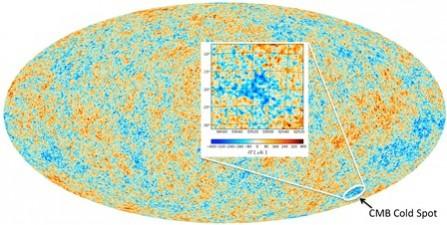
Scientists have discovered a mysterious spot in the space that might have originated as an outcome of a parallel universe crashing into ours, which points towards the first evidence that we might be part of a multiverse.
Also Read: NASA discovers mysterious light flashes all over Earth
A barren region of the universe was detected by astrophysicists in 2015, which was found to be much colder than the rest of the space. The spot also seemed to be missing 10,000 galaxies, the Telegraph revealed.
This region, known as the 'Cold Spot' is located at a distance of 1.8 billion light years away. It is known as the largest structure discovered so far and the findings reveal that it comprises 20 percent less matter than it should have, which has left scientists puzzled.
The scientists speculate that our universe expanded into a vacuum post the Big Bang and many more universes could have formed in the same way formulating a multiverse beyond our space-time.
"One explanation for the Cold Spot is that it might be the remnant signal of the collision of our Universe and one of the trillions of others," Professor Tom Shanks of Durham University's Centre for Extragalactic Astronomy was quoted as saying by the Telegraph.
"If further, more detailed, analysis proves this to be the case then the Cold Spot might be taken as the first evidence for the multiverse – and billions of other universes may exist like our own," Shanks added.
The Cold Spot is situated around three billion light years away from Earth, which is comparatively a close proximity in contrast to other celestial features.
The entire universe is blanketed in cosmic microwave background (CMB), which is a remnant of the Big Bang. But while the temperature of most of the CMB is 2.73 degrees above absolute zero (or -270.43 degrees Celsius), the Cold Spot is about 0.00015 degrees colder than its surroundings.
Before this latest research, most of the scientists believed that that the low temperature in space was due to light.
As per their guestimations, the colder area was a "supervoid" which had 10,000 lesser galaxies and was so barren that it sacked energy from the light travelling through it, shifting its wavelength to the red end of the spectrum, which telescopes mistook for coldness.

But the cohort of researchers found that it is made up of tiny voids which were way too small to shift light.
"The voids we have detected cannot explain the Cold Spot," said doctoral student Ruari Mackenzie of Durham University
"Perhaps the most exciting explanation is that the Cold Spot was caused by collision between our universe and another bubble universe, believe it or not," Prof Shanks tried giving another explanation.
"I remember some scientists suggesting that there could be detectable effects on the galaxy distribution after this 'cosmic shunt' of two universes colliding. Basically colliding universes could leave a slightly anisotropic galaxy distribution in our own universe - a bit like a pile-up on the motorway. So we can look for this to test how seriously to take these ideas," he concluded.






!['He is done with the team now' : Angry Virat Kohli slams the bat, kicks the ground, yells at RCB team as SRH smashes runs [reactions]](https://data1.ibtimes.co.in/en/full/796956/he-done-team-now-angry-virat-kohli-slams-bat-kicks-ground-yells-rcb-team-srh-smashes.jpg?w=220&h=138)






